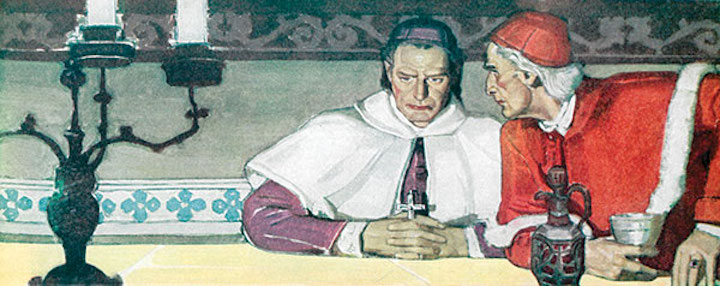The horror of the sexual abuse of minors by Catholic priests, an unspeakable crime, has been compounded in many cases by the decision of Church leaders – bishops and religious superiors – to downplay grave allegations, and to refuse punishing priests found guilty of criminal behavior. The recent exposure by Christine Niles at ChurchMilitant.com of horrendous wrongdoing by priests and superiors of the Society of St. Pius X, founded by Archbishop Marcel Lefebvre, is one more chapter in the shameful history of clerical criminals being protected by negligent, and thus complicit, superiors.
John Lamont reacted to these stunning revelations in an essay that merits careful attention. He spells out a sad reality that is often ignored when considering the sordid history of why church leaders too often have done little or nothing about the criminal behavior of those subject to their authority:
One should begin this analysis by acknowledging that when most people encounter evidence of sexual abuse, they don’t want to hear about it and do their best to deny or ignore it. This is one of the most shocking discoveries made by those who are themselves abused or who attempt to help victims of abuse. The reason for it is that recognizing the existence of sexual abuse leads to accepting difficult, upsetting, and threatening responsibilities. . . .In order to justify this denial, they often attack the victim, whom they resent for having placed them in an uncomfortable situation.
We’ve heard the plea from bishops who were confronted by evidence that they had shielded priests guilty of sexual molestation of minors: “I am not a policeman.” While that is true, there are policemen ready to handle the situation if summoned. Calling the police, however, requires courage and the conviction that it is the bishop’s duty to turn in one of his priests who has committed criminal acts.
It can be an “upsetting and threatening responsibility” to act against a brother priest, but when that priest has misused his authority and power to inflict grave harm upon a young person, personal considerations of comfort are irrelevant if justice is to be upheld. When a crisis lands on the episcopal desk in the form of an accusation of criminal turpitude by a priest any reluctance to act or hostility towards the accuser is simply out of order.
This is the point that Lamont is getting at. When powerful men, such as the SSPX superiors, refuse to act justly in confronting and punishing a grave injustice by one of their subjects, they put their own convenience ahead of everything else. For these high ecclesiastics, it is easier to ignore the grievances of the victims of clerical sexual abuse than to remove the abuser, a clerical colleague who may even be a friend.

Victims have been treated as bothersome money-seekers who would ruin the tranquility of the diocese or religious order if their complaints became known, let alone found to be true after a serious investigation.
The revelations of SSPX shifting molester priests around from assignment to assignment show how the evasive, make-believe mindset of the superiors – “there is nothing to worry about here, so please do not bother us with further complaints about how we handle these matters” – remains a problem in the Church.
The legal order in most free countries places the investigation and punishment of crimes in the hands of a justice system that is in important ways independent of the rulers. Impartiality is better guaranteed when professional prosecutors and non-political judges handle crime and punishment.
In the Catholic Church there is no such separation of powers as is found, for example, in the American Constitution. The bishop of a diocese is the executive, legislative, and judicial authority (major superiors of religious orders enjoy a somewhat similar authority).
This concentration of episcopal power is only subject to the higher authority of the pope. That is why the faithful continue to appeal to the pope for action. This month marks the first anniversary of the promulgation of the papal legislative document Vos Estis Lux Mundi containing new norms dealing with sexual abuse and cover-ups by ecclesiastical authorities. The norms are good, but their consistent application has not been noteworthy.
Christopher Altieri at the Catholic Herald raises pertinent questions about the resignation of Auxiliary Bishop Joseph Binzer of Cincinnati, who had failed to keep his archbishop fully informed of complaints against a priest of the diocese, Fr. Geoff Drew. [Editor’s Note: An earlier version of this column mistakenly reported that this case involved a failure to report “allegations”; according to the diocese there were no formal allegations made either at the parishes where Fr. Drew served or submitted to the chancery. – RR] It is not clear if the procedures of Vos Estis were used in this case.
Vos Estis investigations are underway in the dioceses of Brooklyn and Crookston, but the investigation in the diocese of Buffalo, which led to the resignation of Bishop Richard Malone, surprisingly took the form of an Apostolic Visitation, not a Vos Estis investigation, even though there was sufficient cause to invoke these new norms designed to combat clerical sexual abuse and episcopal cover-ups.
June 20 is the second anniversary of the public revelation that Theodore McCarrick, the laicized former Cardinal Archbishop of Washington, had been credibly accused of the sexual abuse of a minor. We continue to await the promised publication of the results of the Holy See’s internal investigation of the McCarrick matter. Anger and dissatisfaction with the hierarchy will only be dispelled when transparency and accountability are in fact visible.
*Image: A Bishop and a Cardinal by Mead Schaeffer [from the Saturday Evening Post issue of February 14, 1942]. The illustration accompanied Stephen Vincent Benét’s story, “The Bishop’s Beggar.”
















